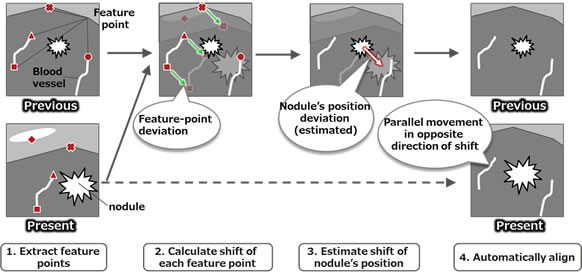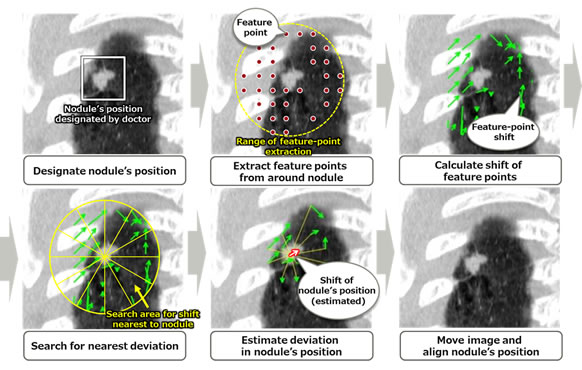Kawasaki, Japan, February 10, 2015
Fujitsu today announced that it has developed a technology for the highly precise alignment of nodules, or growths of cells, within computed tomography (CT) images taken of the same patient on different dates.
In CT imaging, the position of a nodule may change because of a person's heartbeat and breathing. In the past, these images have been aligned using surrounding blood vessels and other features as reference points, but when there are few blood vessels in close proximity, this technique is imprecise.
Fujitsu has now developed a technology that very accurately aligns these images using not only nearby blood vessels, but also those located over a larger area as reference points, even when there are few blood vessels nearby. This new technology was found to be able to align a nodule's position to an error margin of less than 2.5 mm(1), the level needed for practical use, in approximately 80% of cases, up from the roughly 30% of the conventional method. Applying this technology can reduce the time needed to align images, and potentially contribute to lightening the workload on doctors.
Details of this technology are being presented at the Pattern Recognition and Media Understanding (PRMU) Conference opening February 19 at Tohoku University in Sendai, Miyagi Prefecture.
Background
When screening for cancer or monitoring for the changes to the nodule over time, in order to monitor changes in a patient's nodule, doctors compare images taken from the same patient on different dates. For detailed monitoring, doctors manually indicate the position of the nodule for which they would like a magnified view, and they also display a magnified image of the reference nodule used for comparison. When doing so, because a patient's heartbeat and breathing shift the position of the nodule from the previous CT image, doctors must go through the cumbersome process of taking multiple cross-section images to find a match, and then manually align the position of the nodule (Figure 1) using the cross-sections.
 Figure 1: Observing changes in nodules over time by comparing images
Figure 1: Observing changes in nodules over time by comparing images
Larger View (57 KB)
Issues
Conventional methods automatically extract multiple readily identifiable areas, or "feature points," from an area around the nodule region indicated by a doctor in the previous image. In the same manner, the feature points are extracted in the present image. These feature points include blood vessels and the edges of organs which are used as reference points in order to automatically find the position of the nodule (Figure 2). But when there are few feature points near the nodule, alignment accuracy declines. Meanwhile, expanding the area over which feature points are extracted can create a separate set of problems: the feature points themselves shift in different ways due to breathing or other factors, making it difficult to estimate the nodule's position.
 Figure 2: Basic approach for automatic alignment
Figure 2: Basic approach for automatic alignment
About the Technology
Fujitsu Laboratories has developed a technology that accurately aligns nodules automatically by using feature-point references over a larger area when there are few blood vessels or other feature points close to the nodule (Figure 3).
In order to deal with cases where there are few feature points near the nodule, this technology searches for feature points over a larger area than the conventional method. But the shift of feature points farther away from the nodule will not necessarily agree with the deviations in the position of the nodule itself. In order to maximize the likelihood for deviations to agree, this technology weights feature points based on their proximity to the nodule in order to calculate the nodule's position. The nodule-alignment procedure is as follows:
- Extract feature points over a large area from the nodule's center.
- Align the feature points between two images and calculate the shift of feature points.
- Split the region into wedges centered on the nodule's position and find the shift nearest to the nodule's position in each wedge.
- Assign weights to feature points, with feature points closer to the nodule's position being more heavily weighted.
- Calculate the weighted distance and direction of shift from the nodule's position.
- Move the image to cancel out the distance and direction of the calculated shift in the nodule's position.
Feature points that are close to the nodule will move similarly as the body's contiguity, and shift will tend to be similar, so the shift of feature points near the nodule are weighted more heavily, and those weightings are taken into account in calculating the deviations in the nodule's position.
In addition, although processing volume increases with a greater number of feature points used for comparison, processing is actually accelerated as the image features (pattern of peripheral image pixels) is simplified. In this way, matching positions across multiple cross sections can be conducted at high speed.
 Figure 3: Alignment of nodule’s positions by the newly developed method
Figure 3: Alignment of nodule’s positions by the newly developed method
Results
In tests involving cases of pulmonary disease, this new technology was found to be able to align images to an error margin of less than 2.5 mm, the level needed for practical use, in 83% of cases, as compared with 33% with conventional methods. Out of the hundreds of cross-sectional images generated per patient case, the nodule is likely to be present in roughly twenty, from which the nodule position can be aligned in approximately 1.5 seconds. This reduction in time needed for alignment in image diagnoses lightens the workload on doctors.
Future Plans
Fujitsu is conducting practical testing on a wide range of images, with the goal of commercializing into a Fujitsu product during fiscal 2015.
![]() E-mail: multimedia@ml.labs.fujitsu.com
E-mail: multimedia@ml.labs.fujitsu.com

